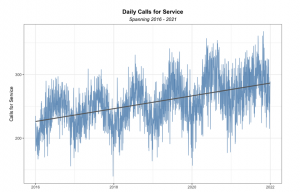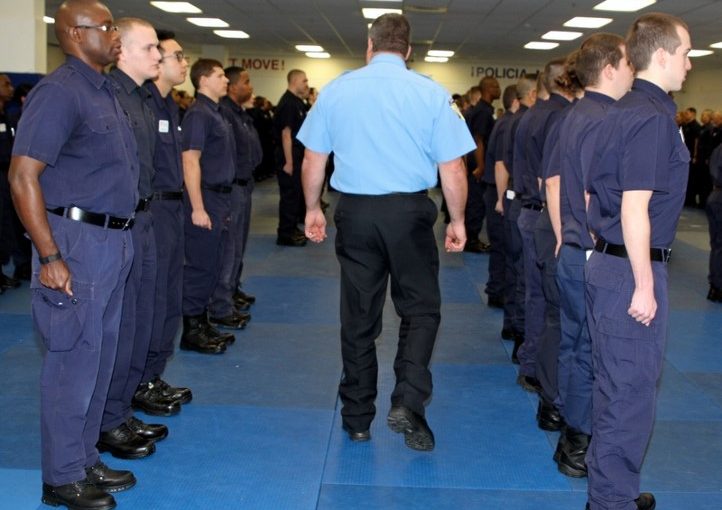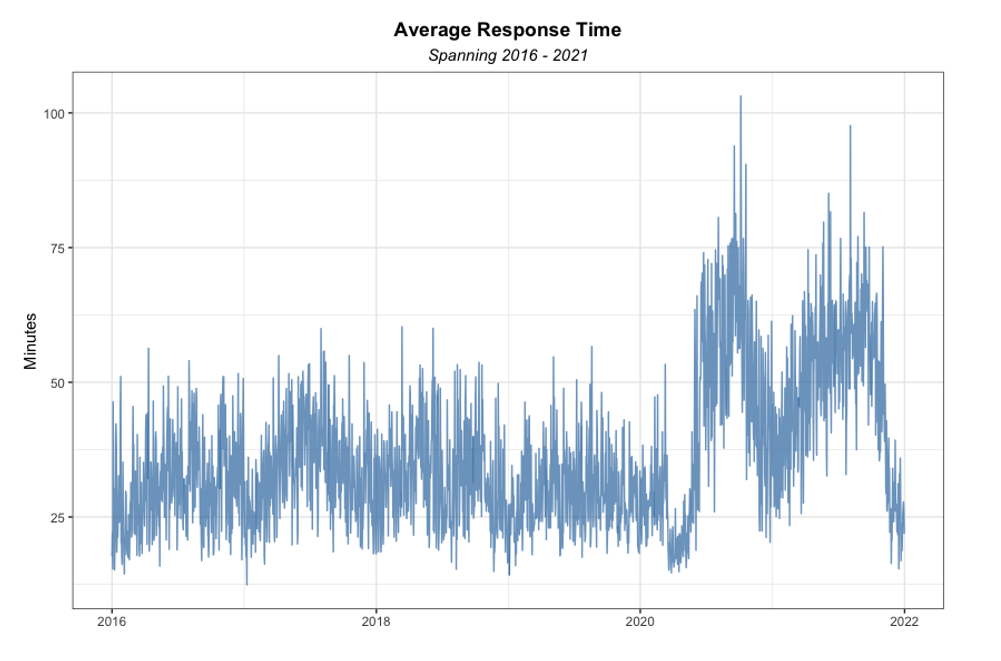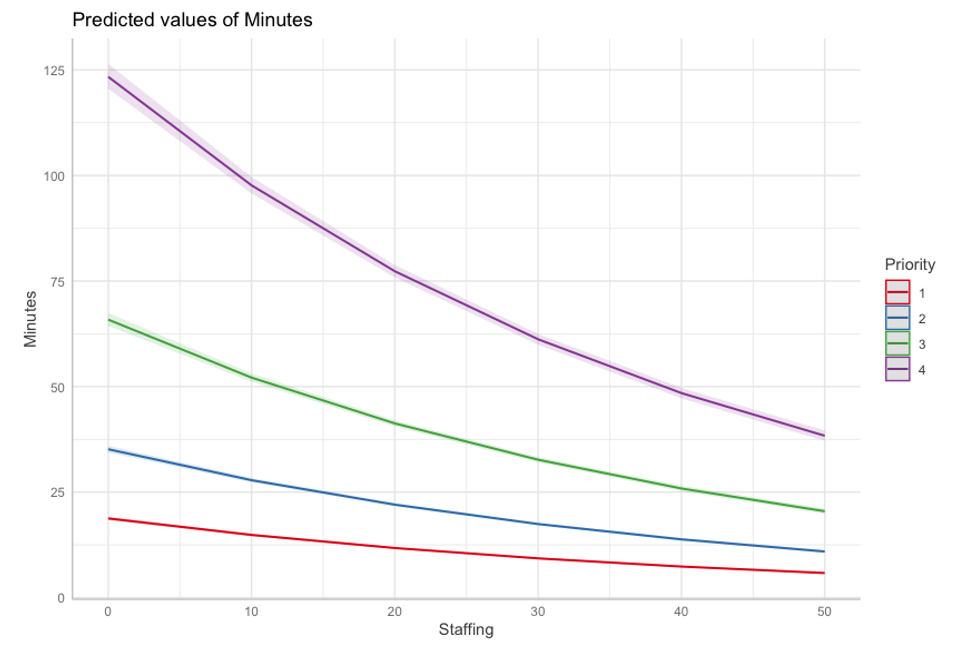While U.S. policing has been experiencing a workforce shortage for decades, the challenge gained further attention in 2020 following the murder of George Floyd and the ensuing civil unrest and highly damaging sociopolitical environment surrounding policing.1 Over the past two years, police executives across the United States have warned about an increased rate of officer retirements and voluntary resignations, with many worried that the events of 2020 exacerbated an already simmering workforce crisis. At the same time, scholars have recently argued that the United States is under-policed, relying instead on overly severe prison sentences to achieve public safety goals, and that public policy should be restructured to prioritize growth in police personnel and service.2
In 2021, the authors documented a sharp rise in officers voluntarily resigning from a large police agency in the western United States following the initial wave of national protests.3 The analysis found a 279 percent increase in resignations between June and December 2020, while the rates of other leaving types (retirements, firings) remained unchanged. The study demonstrated the increase in resignations was linked to the Floyd protests occurring in the city, a hostile sociopolitical environment, and a perceived lack of political support. A one-year projection also indicated that the agency was likely to continue facing high levels of voluntary resignations absent considerable effort. That forecast proved accurate, with resignations continuing until substantial efforts to address the exodus were undertaken. These efforts included significant pay raises (up to 30 percent) beginning in the summer of 2021, which succeeded in terms of slowing down the voluntary resignation spike identified in the study. While that analysis was limited to the experience of a single large agency, agencies across the United States have continued to provide evidence that suggests the agency studied was not unique in facing this challenge.
Many agencies report they experienced similar trends in resignations following the summer of 2020, straining their ability to provide service at the same level as pre-2020. Compounding the problem are reports indicating that many agencies cannot fill the now copious vacancies due to a lack of interested and qualified candidates. These two realities have left many police agencies significantly understaffed, with their remaining officers overworked, overstressed, and burned out.
Impacts of the Police Staffing Crisis
This workforce crisis carries serious risks. Effective policing has a suppression effect on homicides and other serious crimes. Although the size of the effect is the subject of debate, and it undoubtedly varies across communities, policing affects violent crime. Accordingly, a sudden mass departure of officers from a city can have dire consequences for public safety. For example, in a retrospective study of 252 large cities over nearly 40 years, researchers at the Niskanen Center found that for every 11 to 18 officers added to a community, an additional homicide is prevented. In addition, additional police manpower is associated with reduced index crimes as well as reduced index crime arrests, suggesting that the effect of more police manpower does not necessarily lead to more arrests.4 Researchers also noted that “although the total reduction in homicide is roughly equal across black and white victims, the decline in homicide is twice as large for black victims in per capita terms.”5 Thus, a rapid departure of police officers from a jurisdiction may negatively and disproportionately impact communities of color within it.
On this point, research from Eric Piza of the John Jay College of Criminal Justice and Vijay Chillar of Rutgers University is instructive. When the Newark, New Jersey, Police Department laid off 13 percent of its officers in 2010, violent and property crimes suddenly increased. These increases became progressively higher over time. However, in nearby and similarly situated Jersey City, New Jersey, which avoided layoffs, the researchers observed no significant changes in crime.6
Addressing the Crisis
It is not clear whether officers are leaving the profession entirely or leaving their agencies. As agencies increasingly find themselves understaffed, they have responded with hiring bonuses, increased pay, and retention bonuses. Given the currently ultra-competitive job market, this market-based strategy is probably needed; however, the results of these efforts remain to be seen. There are other less tangible efforts agencies can take, though. First (and perhaps, most important), police executives and politicians must strive to improve perceptions of support among police employees. This effort will require thoughtful and patient responses when agencies—or the institution of policing itself—face public backlash following some critical incident. Beyond potentially inflaming community tensions and creating excessive public fear and anxiety, leaders jumping to conclusions or poorly framing incidents may make good police officers consider leaving the department.
Police executives and their political sovereigns must carefully balance their responsibilities to investigate and discipline misconduct quickly but in a way that officers perceive as fair. There is substantial empirical evidence linking perceived organizational justice and desirable officer attitudes and behaviors.7 Officers who perceive greater organizational justice are less sensitive to the ill effects of heightened public scrutiny and less likely to “de-police” in response to a legitimacy crisis.8 A long line of research also demonstrates that when officers perceive fair internal treatment, they are more likely to stay with an agency, perform at a higher level, and remain healthy.9
Excellent policing requires an excellent police workforce. Losing officers to resignations, early retirement, or competing agencies neither improves public safety nor produces fairer treatment of residents. Moreover, against the backdrop of an unprecedented spike in gun violence and homicide, it should be apparent that communities need sufficiently staffed police departments to address this increase in violence and continue to provide adequate public safety services the community expects. This critical need leads to a second suggestion to address co-evolving crime and staffing trends: police departments must learn to leverage their internal data and human capital to provide data-driven analyses and policy recommendations to the political bodies overseeing them.
More and more, political bodies making decisions regarding police agency staffing levels require data-based evidence to justify decisions made on how municipal, county, or state monies are being spent. This move toward evidence is not a negative development. Governments should allocate monies in a fiscally sound manner, which is enhanced by following data-driven analyses. However, who is conducting these analyses matters. In many cases, staffing level analyses are being prepared by individuals who do not have a substantive background in policing. These analysts are less likely to understand the nuances and complexities of police staffing levels. Conversely, a police agency may advocate for increasing police staffing levels (or other police-related resources) based on their subject-matter expertise but fail to provide robust data-based analysis to justify their recommendations. Neither option is ideal.
Many agencies have personnel who hold graduate degrees that prepare them to conduct the type of statistical analyses that allow them to combine subject matter expertise with technical expertise. These personnel should be leveraged when trying to convey to policy makers what an agency needs to continue providing adequate service levels. A recent analysis of response times conducted by Deputy Chief Scott Mourtgos at the Salt Lake City, Utah, Police Department (SLCPD) provides an example of employing this strategy.
Using Data to Respond
In 2021, SLCPD’s response times to calls for service (CFS) increased and came under scrutiny. Response times to CFS is a metric most agencies are constantly striving to improve. Faster response times to CFS can increase crime clearance rates, the probability of apprehending suspects, and public safety.10 Meanwhile, an increasing inability to respond to CFS in a timely manner can erode public trust.11 On balance, the financial cost of additional officers to minimize response times to the appropriate level is far less than the costs of crimes that go undeterred due to slower response times.12
Response times vary across different communities and are dependent on many complex factors that are distinctive to each jurisdiction. Salt Lake City is one of the fastest-growing cities in the United States. Increased turnover in the past year and a half (like many other agencies) has led to a struggle to keep patrol staffing levels in sync with demand. While agencies can employ numerous strategies to reduce response times (e.g., telephonic response or online reporting), the reality is that much of policing requires a physical police response.
Using SLCPD as an example, Deputy Chief Mourtgos analyzed daily computer-aided dispatch (CAD) data from January 2016 through December 2021. The goal of the analysis was to accurately assess to what degree variation in staffing levels influences response times to CFS. Systematically assessing response times in a data-driven manner is essential to providing political stakeholders with tangible estimates of possible gains in response times based on specific changes in staffing levels.
The trend of all CFS across the six years examined is displayed in Figure 1. There is a clear increasing trend in CFS across the entire period. Increasing public service demand is even more problematic when staffing levels have decreased over the past two years due to turnover.
Figure 1  |
Figure 2 displays the average response time, pooled across priority levels and shifts. One can see that aggregate response time was stable through 2019. There appears to be a decrease through 2019 until a more noticeable decrease occurs in the first half of 2020. Significant spikes followed in the second half of 2020 and 2021. The drop at the beginning of 2020 is attributable to the COVID-19 pandemic, with the subsequent spikes attributed to the local atmosphere surrounding policing following the murder of George Floyd and the subsequent substantial loss of personnel that followed. It is important to note these abrupt changes, as they need to be accounted for in any statistical model predicting future response times.
|
Figure 2
|
Many factors influence response times beyond call volume, including events such as the COVID-19 pandemic and civil unrest. These must all be accounted for in any statistical model to predict the effect of staffing levels on response times accurately. In the analysis conducted for SLCPD, the following variables were included to provide the most accurate predictions for how staffing levels affect response times:
- Call priority level (Priorities 1–4: Priority 1 calls are the most urgent, including all in-progress crimes and major crimes that occurred within a time-lapse of five minutes or less for property crimes and fifteen minutes or less for crimes against a person.)
- Geographic division
- Hour of day
- Day of week
- Month of year
- Number of officers dispatched
- Patrol staffing levels
- The volume of on-view (proactive) activity
- Volume of CFS
Once the model was constructed and checked for accuracy, predictions were estimated for each patrol shift: day, afternoon, and graveyard (nights). Table 1 provides predicted response times for each shift at staffing levels ranging from 20 to 30 patrol officers.
Table 1: Predicted Response Times by Shift
|
|||
| Day Shift | |||
| Priority | Staffing (Shift Average = 20) | Predicted | Reduction |
| 1 | 20 | 12.56 | |
| 25 | 11.78 | -0.78 Minutes | |
| 30 | 11.06 | -1.5 Minutes | |
| 2 | 20 | 23.66 | |
| 25 | 22.30 | -1.46 Minutes | |
| 30 | 20.84 | -2.82 Minutes | |
| 3 | 20 | 44.59 | |
| 25 | 41.84 | -2.74 Minutes | |
| 30 | 39.28 | -5.31 Minutes | |
| 4 | 20 | 84.04 | |
| 25 | 78.87 | -5.17 Minutes | |
| 30 | 74.03 | -10.01 Minutes | |
| Afternoon Shift | |||
| Priority | Staffing (Shift Average = 22) | Predicted | Reduction |
| 1 | 20 | 11.75 | |
| 25 | 10.45 | -1.3 Minutes | |
| 30 | 9.30 | -2.45 Minutes | |
| 2 | 20 | 22.02 | |
| 25 | 19.59 | -2.43 Minutes | |
| 30 | 17.43 | -4.59 Minutes | |
| 3 | 20 | 41.27 | |
| 25 | 36.72 | -4.55 Minutes | |
| 30 | 32.67 | -8.60 Minutes | |
| 4 | 20 | 77.32 | |
| 25 | 68.79 | -8.53 Minutes | |
| 30 | 61.20 | -16.12 Minutes | |
| Graveyard Shift | |||
| Priority | Staffing (Shift Average = 21) | Predicted | Reduction |
| 1 | 20 | 9.33 | |
| 25 | 8.64 | -0.69 Minutes | |
| 30 | 8.00 | -1.33 Minutes | |
| 2 | 20 | 15.42 | |
| 25 | 14.27 | -1.15 Minutes | |
| 30 | 13.21 | -2.21 Minutes | |
| 3 | 20 | 25.46 | |
| 25 | 23.57 | -1.89 Minutes | |
| 30 | 21.82 | -3.64 Minutes | |
| 4 | 20 | 42.06 | |
| 25 | 38.94 | -3.12 Minutes | |
| 30 | 36.05 | -6.01 Minutes | |
Increasing patrol staffing decreases response times across every shift and call priority level. The model predicts that if each patrol shift had an increase of 10 officers on duty, on average, SLCPD would expect to see a 12 percent decrease in response times on the day shift, a 21 percent decrease in response times on the afternoon shift, and a 14 percent decrease in response times on the graveyard shift. Further gains could be realized as staffing levels are increased even more.
Figure 3 visualizes the expected reductions for the afternoon shift. For example, adding five additional officers to the afternoon shift would reduce the response time to a Priority 1 call by 1.3 minutes. Adding 10 officers would reduce that response by 2.4 minutes, or in other words, facilitate a 21 percent faster response. These calls involve the potential loss of life, and reductions of this magnitude could conceivably reduce the number of violent deaths and trauma in a community. This tradeoff embodies the close relationship between police staffing and public safety.
|
Figure 3
|
The above analysis provides a data-driven approach to estimating the effect increased patrol staffing would have on response times in Salt Lake City. Increasing staffing levels in expectation of increased demand is a responsible way of providing public safety. The reality of police work requires officers to be available to respond to calls. The above analysis provides tangible evidence of the positive impact increased staffing can have on response times. This information can be provided to policy makers in an understandable format that explicitly documents the tradeoff between staffing levels and the response times communities expect when they call for help.
Looking Forward
While it is common sense to say increased patrol staffing levels decrease response times, policy makers often require specific estimates and analyses similar to what is briefly demonstrated here. Further, subject matter expertise is needed when explaining the outcomes to minimize misinterpretation. For example, a policy maker using an analyst not familiar with policing may look at these results and suggest officers be moved from specialty and investigative positions to patrol to relieve the political pressure from community members upset with response times. SLCPD downsized many of its specialty and investigative units in 2020 by doing just that to combat rising response times. However, even with a substantial influx of patrol staffing, response times continued to increase. This may reflect a level of demand that could no longer be made up for with increased effort. It may reflect the fallout of the highly negative environment surrounding policing. It may also reflect increased requirements on patrol officers that demand them to spend a more protracted time on CFS—more paperwork, video-tagging, and efforts at resolution, which are required of officers more now than even two years ago. The most likely explanation is a combination of all three factors.
The movement of specialty and investigative positions to patrol may be the correct course in some situations. However, substantial personnel redistribution of this sort leaves other vital responsibilities within the police department understaffed to a point where additional losses cannot be absorbed. As a city grows and demand for services increases (see Figure 1), police executives need to be able to convey the need for incremental increases in the level of authorized staffing. Taking advantage of the data trove every agency has and the human capital within their agencies to conduct robust analyses allows police agencies to more effectively advocate for their agencies and the officers on the street trying to keep up with demand in a challenging environment. As crime trends, staffing trends, and demand for services continue to evolve over the coming years, data-driven practice becomes more critical. d
Notes:
1Justin Nix, Ian T. Adams, and Scott M. Mourtgos, “Arresting the Recruitment Crisis,” City Journal(Autumn 2021).
2Christopher Lewis and Adaner Usmani, “The Injustice of Under-Policing in America,” American Journal of Law and Equality (August 2022): 85–106.
3Scott M. Mourtgos, Ian T. Adams, and Justin Nix, “Elevated Police Turnover Following the Summer of George Floyd Protests: A Synthetic Control Study,” Criminology & Public Policy 21, no. 1 (February 2022): 9–33.
4Aaron Chalfin et al., “When Cities Add Cops, Black Residents Could Have the Most to Gain—And the Most to Lose,” Niskanen Center, May 18, 2021.
5Aaron Chalfin et al., “Police Force Size and Civilian Race” (working paper, National Bureau of Economic Research, Cambridge, MA, 2020).
6Eric L. Piza and Vijay F. Chillar, “The Effect of Police Layoffs on Crime: A Natural Experiment Involving New Jersey’s Two Largest Cities,” Justice Evaluation Journal 4, no. 2 (2021): 176–196.
7Scott E. Wolfe and Spencer G. Lawson, “The Organizational Justice Effect among Criminal Justice Employees: A Meta-Analysis,” Criminology 58, no. 4 (November 2020): 619–644.
8Justin Nix and Scott E. Wolfe, “Sensitivity to the Ferguson Effect: The Role of Managerial Organizational Justice,” Journal of Criminal Justice 47 (December 2016): 12–20; Scott M. Mourtgos and Ian T. Adams, “The Rhetoric of De-Policing: Evaluating Open-Ended Survey Responses from Police Officers with Machine Learning-Based Structural Topic Modeling,” Journal of Criminal Justice 64 (September–October 2019): 101627.
9Ian T. Adams and Sharon H. Mastracci, “Police Body-Worn Cameras: Effects on Officers’ Burnout and Perceived Organizational Support,” Police Quarterly 22, no. 1 (March 2019): 5–30.
10Jordi Blanes Vidal and Tom Kirchmaier, “The Effect of Police Response Time on Crime Clearance Rates,” The Review of Economic Studies 85, no. 2 (April 2018): 855–891; Abdullah Cihan, Yan Zhang, and Larry Hoover, “Police Response Time to In-Progress Burglary: A Multilevel Analysis,” Police Quarterly 15, no. 3 (September 2012): 308–327; Chenhui Liu, “Exploration of the Police Response Time to Motor-Vehicle Crashes in Pennsylvania, USA,” Journal of Safety Research 80 (February 2022): 243–253.
11Charles E MacLean, “Improving African American Confidence in Law Enforcement: Recruit to Optimize Procedural Justice, Not Racial Quotas,” International Journal of Police Science & Management 23, no. 2 (June 2021): 102–118; Mourtgos, Adams, and Nix, “Elevated Police Turnover Following the Summer of George Floyd Protests.”
12Vidal and Kirchmaier, “The Effect of Police Response Time on Crime Clearance Rates.”
Please cite as
Scott M. Mourtgos, Ian T. Adams, and Justin Nix, “Linking the Workforce Crisis, Crime, and Response Time,” Police Chief Online, August 24, 2022.





